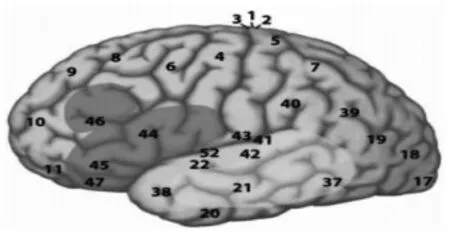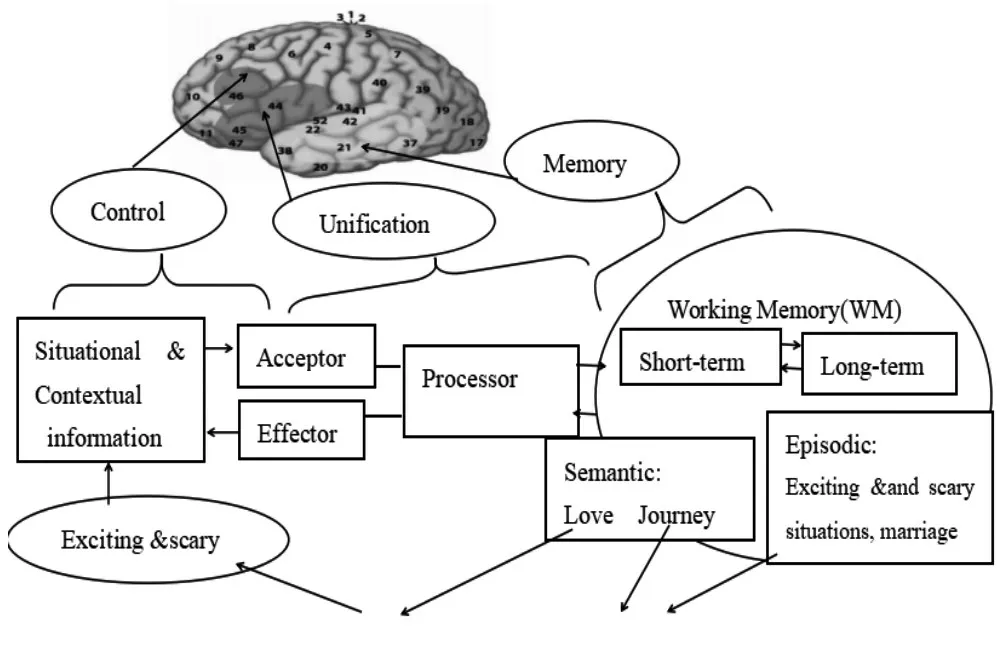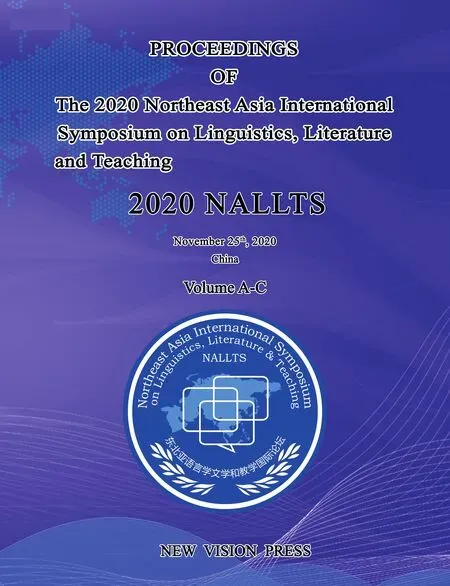COGNITIVE METAPHOR PROCESSING BASED ON MUC THEORY
School of Foreign Studies,Shandong University of Finance and Economics,Jinan,China Email:419340495@qq.com
[Abstract]This paper attempts to deal with metaphor interpretation in human information processing system(IPS)based on Memory-Unification-Control(MUC)theory,explaining the processing(production and understanding)of metaphorical information,with the three functional components of language processing-memory,unification and control-cooperating in human IPS.By constructing a model of metaphor processing in IPS,this paper argues that metaphor processing is not just memory retrieval of lexical items in different categories or simply combination of one concept with another,but a dynamic and integrated cognitive process involving the mapping of features from one concept onto another,with related attributes of Topic and Vehicle activated and unified in the processing course.
[Keywords]Cognitive metaphor;Information processing;MUC Theory;Metaphor interpretation and memory
Introduction
Cognitive linguistics sees metaphor as a means whereby ever more abstract and intangible areas of experience can be conceptualized in terms of the familiar and concrete based on human bodily experiences.Metaphor interpretation is related to some basic issues in cognitive linguistics such as categorization,prototype,gestalt perception and schema.Metaphor is regarded as being in the central position of human cognition and as an underpinning construct,providing foundation for thought and conceptualization.Metaphor is mental representation reflecting the similarity relations between category members,and it has the embodied nature of categorization,essentially a matter of both human experience and imagination,human perception of the world with created mental imagery.Metaphor deals with embodied,encultured,and imaginative dimensions of meaning,and it is human perception and understanding of the world.
Cognitive linguists,whether on stand of cognitive semantic or cognitive pragmatic views,all agree on the cognitive nature of metaphor.This paper attempts to integrate cognitive metaphor interpretation into information processing system,and tries to interpret cognitive metaphor in Memory-Unification-Control(MUC)theory from information processing perspective,exploring a new approach in metaphor interpretation.
METAPHOR INTERPRETATION AND MEMORY
In interpreting metaphor cognition,Lakoff’s Conceptual Metaphor Theory(CMT)(Lakoff,1987;Lakoff&Johnson 1980; Lakoff & Turner,1989)emphasizes the universally conceptual nature of metaphor in cognitive semantic field,proposing that metaphors are understood via reference to metaphoric correspondences that structure our understanding of abstract concepts,and conceptual metaphors are systematic mappings across conceptual domains.While Glucksberg’s Attributive Categorization View(ACV)(Glucksberg,1991; Glucksberg & Keysar,1990; McGlone,1996)highlights class-inclusion model,and argues that metaphors,like many literal comparisons,are understood by casting the Topic and Vehicle concepts in a common category,stressing a kind of decomposition of the perceived whole into individual properties or attributes according to personal understanding of the interpreter,leaning to cognitive pragmatic perspective.
The apparent difference between the CMT and ACV is the way of metaphor interpretation,but they share something in common that metaphor is cognitive in nature.Although they emphasize different cognitive perspectives in metaphor understanding,we can generalize from their views that metaphor interpretation is closely related to human memory.Most metaphorical expressions instantiate preexisting metaphorical mappings in our memory by which information from a target domain is partly understood in terms of a dissimilar source domain,and these conceptual metaphors motivate the meanings of metaphorical expressions which should be understood with reference to the newlycreated category which is exemplified by the Vehicle concept.In understanding some metaphor expressions,preexisting metaphorical mappings between two concepts are retrieved from our memory,while the generated meaning is context-dependent or situation-dependent.
Cameron(2003)argues that Aristotle was already making a point that some later philosophers(Saddock,1993;Searle,1993)chose to ignore:that metaphor is not a matter of semantics or pragmatics,but of both.Ungerer &Schmid(2001)suggests that people’s perception of the outer world may indeed involve two stages:the perception of an object as a whole as the first step(the so-called holistic perception,or gestalt perception,which is reflected in CMT’s interpretation process),and a kind of decomposition of the perceived whole into individual properties as a second(optional)step(which is reflected in the ACV’s interpretation process).Gibbs(1994)believes that the interpretation of metaphorical statements does not necessarily require some earlier temporal contrasts of diverse knowledge domains,because such metaphorical mappings may already exist in long-term memory.Nayak and Gibbs(1990)suggests a possibility that conceptual metaphor is available in conceptual-semantic memory,and maybe retrieved in certain situations.In this scenario,conceptual metaphors are not necessary for immediate comprehension,but may be recognized and appreciated in contexts that motivate people to search for an underlying metaphorical theme.Gibbs(1996)thinks concepts are temporary,independent constructions in working memory created on the spot from generic and episodic information in long-term memory.In this case,memory provides basic knowledge for metaphor understanding.
INFORMATION PROCESSING AND MUC THEORY
By combining the two theories in explaining metaphor related to human memory,it can be seen that both of their analyses of metaphor interpretation involve the process of information perception based on human experience,information memorization in form of concept and gestalt,information retrieval from human memory and language understanding and processing,which is what information processing theories talk about.Therefore,how cognitive metaphor is processed in human brain could be interpreted from information processing perspective.
Information Processing System
The process of people’s acquiring and applying knowledge is in fact the process of inputting,storing and recalling of information,and in a sense,is the process of information memorization(Peng,2000).This process forms a system,that is,information processing system(IPS),which is a system that can receive,store,process and transfer information.According to Liang Ningjian(2003),individuals change the stimulus information perceived from environment into cognitive code(e.g.,visual image or acoustic or semantic code,etc.),and then pass it into processor of our brain,in which the cognitive code is analyzed and organized.The processed cognitive code is then passed into working memory(short-term)memory,which processes or modifies the cognitive code according to individual purpose and expectation.Then the modified cognitive code is passed into long-term memory.Long-term memory is regarded as a huge storage of knowledge and experiences which stores not only factual knowledge but also procedural knowledge.In certain circumstances,knowledge and experiences stored in short-term memory and long-term memory are activated to be applied into practice via effector,hence the output of information.
This model of human IPS provides a general framework for the analysis of metaphor comprehension process.In the following section,cognitive metaphor processing in information processing perspective based on MUC theory would be explored.
MUC Theory
Metaphorical expressions show the expressive power of human language deriving from the possibility to combine elements from human memory and experience in novel ways.And this process of generating new meaning from elements in human memory is called Unification according to Hagoort(2013).Hagoort(2005,2013)proposed the Memory-Unification-Control(MUC)model to explain language production and comprehension from neurobiological perspective.
According to Hagoort(2013),the MUC model distinguishes three functional components of language processing:Memory,Unification and Control.The Memory component refers to the linguistic knowledge that gets encoded in the course of language acquisition and consolidated in neocortical memory structures.The knowledge about the building blocks of language such as phonological,morphological and syntactic building blocks is domain specific and hence coded in a format that is different from cor and visual object information.But in fact,language processing is not just memory retrieval or the simple concatenation of lexical items.Elements in human memory sometimes are combined in novel ways.In Hagoort’s MUC model,this process of deriving new and complex meaning from the lexical building blocks is referred to as Unification.Unification refers to the assembly of pieces stored in memory into larger structures,with contributions from context.Unification operations take place not only at the syntactic processing level,but across representational domains.The Control component relates language to joint action and social interaction.When executive control is evoked,languages also have built-in linguistic devices that trigger the attentional control system into operation.
Hagoort(2013)explicitly examined the distribution of labor of different functioning regions in human brain(refer to Figure 1 for specific distribution of the activation).Memory areas are in the temporal cortex and the angular gyrus in parietal cortex(Brodmann areas(BA)21,37 and 42),which subserve the knowledge representations that have been laid down in memory during acquisition.These regions store both low-level word information(including phonological word forms,morphological information and the syntactic templates associated with nouns,verbs adjectives)and highlevel semantic information,with especially conceptual knowledge widely distributed in these zones.Broca’s area(BA 44 and 45)and adjacent cortex(BA 47 and 6)in the frontal regions are in charge of unification operations.Larger structures from the building blocks retrieved from memory are generated in Unification operations.Semantic unification(recruiting BA47 and BA45),syntactic unification(focus in BA45 and BA44)and phonological processes(BA44 and ventral parts of BA6)recruit different parts in human brain.And Control regions involve dorsolateral prefrontal cortex(BA46).In executive control process,attention is paid to the most relevant information in the input,involving anterior cingulate cortex and the parts of parietal cortex.

Figure 1:MUC model of language(Hagoort,2013,p.2)
Cognitive metaphor,as part of human cognition,has great power in generating new meanings by building languages and concepts in different categories into larger units.In the process of storing,processing and transferring information in IPS,metaphorical thinking is supposed to be functioning through its working mechanisms recruiting activities in different regions of human brain.Then the exploration of cognitive metaphor in information processing based on MUC theory is necessary and possible.
COGNITIVE METAPHOR IN INFORMATION PROCESSING BASED ON MUC THEORY
Daily metaphor expressions derived from human metaphorical thinking are linguistic knowledge encoded in human language acquisition and consolidated in human memory structures.And this part of knowledge stored in human memory is organized in certain units such as in the from of schema,which would be rolled on to construct a larger unit.And this unit of knowledge is constructed in human brain as an integrated whole,a gestalt.Thew creative power of human cognition is reflected in the combination of elements in different units,and when the elements of different units are linked by way of metaphorical mapping based on similarity or interaction,metaphorical expressions would be produced.
Comprehension for metaphorical expressions also involves human memory,both semantic and episodic memory(Paivio & Walsh,1993),and the linguistic and extralinguistic context in which it was uttered.The linguistic context includes the ongoing topic of conversation,and the extralinguistic context includes the general communicational setting and the persons involved in the exchange.All these situational stimuli will determine precisely what semantic memory information is relevant to the interpretation of the metaphorical expression.Metaphoric expression,as vivid and special verbal stimulus,when perceived,would be changed into mental image and then passed into short-term memory and long-term memory respectively.The mental image of the metaphoric expression is so vivid that it is stored in our brain solidly,memorable.In the recall of the information,the metaphoric expression and the situation provide the retrieval context that guide the search through long-term memory.In view of Paivio,A.and Walsh,M.(1993),memorability depends on such long-term memory characteristics as the concreteness or meaningfulness.Thus the vivid image plays an important role in memory and recall of metaphoric expressions,and the pleasing mental effort required to understand them makes them memorable.
Metaphor,as an important part in human cognition,would be interpreted in information processing based on MUC theory,which is hoped to find a suitable place for metaphor in human cognition in terms of IPS and neuro-linguistic MUC theory.
The creative magic of metaphor thinking is the reflection of power of human cognition in combining elements from human memory and experience in novel ways.The processing course of metaphor(the production and understanding of metaphorical expressions)will be illustrated,with distribution of different functional regions of human brain and the three functional components shown in Figure 2,taking the metaphorical expression“Our marriage was a rollercoaster ride”as an example.

Figure 2:Cognitive metaphor in information processing based on MUC theory
The production of a metaphor expression would be interpreted in the following way:
1)In our memory,some linguistic knowledge and epidemic memories are stored,which get encoded and consolidated in our long-term working memory and can be extracted into short-term working memory to be processed when necessary;and among the stored information,love and journey are stored as concepts in different categories with different attributes or personalities(BA21,37 and 42);
2)We meet some situation in our marriage,which is exciting and scary in some way;in our interpretation of this situation,we just focus on and pay attention to the exciting and scary part of the marriage by Controlling mechanism(BA46);
3)This situational information is accepted and processed in Unification stage,during which pieces of information about exciting and scary situation such as rollercoaster ride or bungee jumping is evoked and assembled into certain structures and linked to the present exciting and scary marriage(BA44,45,47 and 6);
4)Then from long-term working memory,we retrieve information about marriage or love and information about exciting and scary movements such as rollercoaster ride or bungee jumping to short-term working memory,where all the extracted information is integrated,and the two categories of love and journey are linked into a new structure(BA44,45,47 and 6,BA21,37 and 42);
5)Hence,futures of exciting and scary movements(rollercoaster ride or bungee jumping)are mapped onto the concept love or marriage,and the metaphoric expressions such as“our marriage is a rollercoaster ride”or“our marriage is a bungee jumping”are created(BA44,45,47 and 6,BA21,37 and 42).
The understanding of a metaphor expression would be interpreted in the following way:
1)In daily conversation,we meet an expression“our marriage is a rollercoaster ride”or“our marriage is a bungee jumping”,and it is hard to connect“our marriage”with“ rollercoaster ride”or“bungee jumping”because they belong into different categories in our cognition;
2)This verbal information is accepted and processed in Unification course,during which the two concepts in the representation are integrated by searching our memory for related information(BA44,45,47 and 6); during the searching for the related information,our attention is paid to the specific features of rollercoaster ride or bungee jumping that can explain the very situation of our marriage mentioned in the metaphoric expression,and in this process,Control mechanism is functioning(BA46);
3)In our memory,some linguistic knowledge and epidemic memories about love(marriage)and journey(rollercoaster ride or bungee jumping)are stored,which get encoded and consolidated in our long-term working memory(BA21,37 and 42); we extract the related attributes of the two concepts from long-term working memory into shortterm working memory;then the features of rollercoaster ride or bungee jumping(exciting and scary)are mapped onto“our marriage”,and then we get the understanding that“our marriage is in an exciting and scary situation”(BA44,45,47 and 6,BA21,37 and 42).
In the production and understanding of the metaphorical information,the three functional components of language processing-Memory,Unification and Control-play important roles and cooperate in human IPS.Metaphor processing is more than memory retrieval of lexical items in different categories,and it is not simply combination of one concept with another but a unified processing course of two concepts across representational domains,with related attributes of Topic and Vehicle of a metaphor activated and unified in the processing course.
CONCLUSION
This paper deals with metaphor interpretation in human information processing system based on MUC theory,attempting the possibility of highlighting cognitive nature of metaphor in information processing perspective.
Metaphor processing is not just memory retrieval of lexical items in different categories or simply combination of one concept with another,but a dynamic and integrated cognitive process involving the mapping of features or attributes from one concept onto another.It is a processing course of two concepts across representational domains,with related attributes of Topic and Vehicle of a metaphor activated and unified in the processing course.This chapter attempts to illustrate the interpretation of metaphor by integrating MUC theory in explaining the production and understanding of the metaphorical information,with the three functional components of language processing-Memory,Unification and Control-cooperating in human IPS.
 Proceedings of Northeast Asia International Symposium on Linguistics,Literature and Teaching2020年0期
Proceedings of Northeast Asia International Symposium on Linguistics,Literature and Teaching2020年0期
- Proceedings of Northeast Asia International Symposium on Linguistics,Literature and Teaching的其它文章
- Exploration of the SPOC-based Blended Teaching Model:Case Study of Business English Course
- Reducing Students’Foreign Language Speaking Anxiety Through Drama Performance
- An Action Research on Blended Learning through News Broadcasts in EFL Listening Context
- Growth Mindset in Teaching
- A Study on Corpus Stylistics Assisted English and American Literature Teaching
- Promoting Architectural Values in Culturebound Scenery in Tourist Destinations
